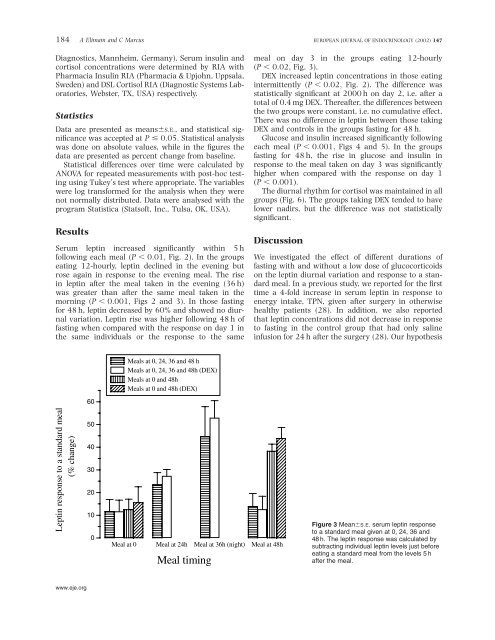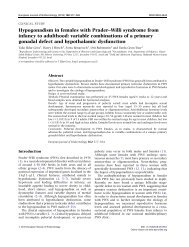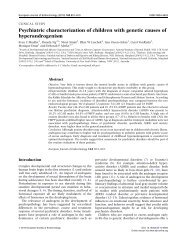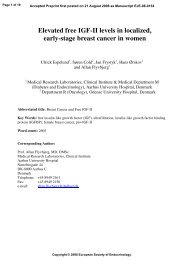Meal timing, fasting and glucocorticoids interplay in serum leptin ...
Meal timing, fasting and glucocorticoids interplay in serum leptin ...
Meal timing, fasting and glucocorticoids interplay in serum leptin ...
You also want an ePaper? Increase the reach of your titles
YUMPU automatically turns print PDFs into web optimized ePapers that Google loves.
184 A Elimam <strong>and</strong> C Marcus EUROPEAN JOURNAL OF ENDOCRINOLOGY (2002) 147<br />
Diagnostics, Mannheim, Germany). Serum <strong>in</strong>sul<strong>in</strong> <strong>and</strong><br />
cortisol concentrations were determ<strong>in</strong>ed by RIA with<br />
Pharmacia Insul<strong>in</strong> RIA (Pharmacia & Upjohn, Uppsala,<br />
Sweden) <strong>and</strong> DSL Cortisol RIA (Diagnostic Systems Laboratories,<br />
Webster, TX, USA) respectively.<br />
Statistics<br />
Data are presented as means^S.E., <strong>and</strong> statistical significance<br />
was accepted at P # 0:05: Statistical analysis<br />
was done on absolute values, while <strong>in</strong> the figures the<br />
data are presented as percent change from basel<strong>in</strong>e.<br />
Statistical differences over time were calculated by<br />
ANOVA for repeated measurements with post-hoc test<strong>in</strong>g<br />
us<strong>in</strong>g Tukey’s test where appropriate. The variables<br />
were log transformed for the analysis when they were<br />
not normally distributed. Data were analysed with the<br />
program Statistica (Statsoft, Inc., Tulsa, OK, USA).<br />
Results<br />
Serum lept<strong>in</strong> <strong>in</strong>creased significantly with<strong>in</strong> 5 h<br />
follow<strong>in</strong>g each meal (P , 0:01; Fig. 2). In the groups<br />
eat<strong>in</strong>g 12-hourly, lept<strong>in</strong> decl<strong>in</strong>ed <strong>in</strong> the even<strong>in</strong>g but<br />
rose aga<strong>in</strong> <strong>in</strong> response to the even<strong>in</strong>g meal. The rise<br />
<strong>in</strong> lept<strong>in</strong> after the meal taken <strong>in</strong> the even<strong>in</strong>g (36 h)<br />
was greater than after the same meal taken <strong>in</strong> the<br />
morn<strong>in</strong>g (P , 0:001; Figs 2 <strong>and</strong> 3). In those <strong>fast<strong>in</strong>g</strong><br />
for 48 h, lept<strong>in</strong> decreased by 60% <strong>and</strong> showed no diurnal<br />
variation. Lept<strong>in</strong> rise was higher follow<strong>in</strong>g 48 h of<br />
<strong>fast<strong>in</strong>g</strong> when compared with the response on day 1 <strong>in</strong><br />
the same <strong>in</strong>dividuals or the response to the same<br />
Lept<strong>in</strong> response to a st<strong>and</strong>ard meal<br />
(% change)<br />
www.eje.org<br />
60<br />
50<br />
40<br />
30<br />
20<br />
10<br />
0<br />
<strong>Meal</strong>s at 0, 24, 36 <strong>and</strong> 48 h<br />
<strong>Meal</strong>s at 0, 24, 36 <strong>and</strong> 48h (DEX)<br />
<strong>Meal</strong>s at 0 <strong>and</strong> 48h<br />
<strong>Meal</strong>s at 0 <strong>and</strong> 48h (DEX)<br />
meal on day 3 <strong>in</strong> the groups eat<strong>in</strong>g 12-hourly<br />
(P , 0:02; Fig. 3).<br />
DEX <strong>in</strong>creased lept<strong>in</strong> concentrations <strong>in</strong> those eat<strong>in</strong>g<br />
<strong>in</strong>termittently (P , 0:02; Fig. 2). The difference was<br />
statistically significant at 2000 h on day 2, i.e. after a<br />
total of 0.4 mg DEX. Thereafter, the differences between<br />
the two groups were constant, i.e. no cumulative effect.<br />
There was no difference <strong>in</strong> lept<strong>in</strong> between those tak<strong>in</strong>g<br />
DEX <strong>and</strong> controls <strong>in</strong> the groups <strong>fast<strong>in</strong>g</strong> for 48 h.<br />
Glucose <strong>and</strong> <strong>in</strong>sul<strong>in</strong> <strong>in</strong>creased significantly follow<strong>in</strong>g<br />
each meal (P , 0:001; Figs 4 <strong>and</strong> 5). In the groups<br />
<strong>fast<strong>in</strong>g</strong> for 48 h, the rise <strong>in</strong> glucose <strong>and</strong> <strong>in</strong>sul<strong>in</strong> <strong>in</strong><br />
response to the meal taken on day 3 was significantly<br />
higher when compared with the response on day 1<br />
ðP , 0:001Þ:<br />
The diurnal rhythm for cortisol was ma<strong>in</strong>ta<strong>in</strong>ed <strong>in</strong> all<br />
groups (Fig. 6). The groups tak<strong>in</strong>g DEX tended to have<br />
lower nadirs, but the difference was not statistically<br />
significant.<br />
Discussion<br />
<strong>Meal</strong> at 0 <strong>Meal</strong> at 24h <strong>Meal</strong> at 36h (night) <strong>Meal</strong> at 48h<br />
<strong>Meal</strong> <strong>tim<strong>in</strong>g</strong><br />
We <strong>in</strong>vestigated the effect of different durations of<br />
<strong>fast<strong>in</strong>g</strong> with <strong>and</strong> without a low dose of <strong>glucocorticoids</strong><br />
on the lept<strong>in</strong> diurnal variation <strong>and</strong> response to a st<strong>and</strong>ard<br />
meal. In a previous study, we reported for the first<br />
time a 4-fold <strong>in</strong>crease <strong>in</strong> <strong>serum</strong> lept<strong>in</strong> <strong>in</strong> response to<br />
energy <strong>in</strong>take, TPN, given after surgery <strong>in</strong> otherwise<br />
healthy patients (28). In addition, we also reported<br />
that lept<strong>in</strong> concentrations did not decrease <strong>in</strong> response<br />
to <strong>fast<strong>in</strong>g</strong> <strong>in</strong> the control group that had only sal<strong>in</strong>e<br />
<strong>in</strong>fusion for 24 h after the surgery (28). Our hypothesis<br />
Figure 3 Mean^S.E. <strong>serum</strong> lept<strong>in</strong> response<br />
to a st<strong>and</strong>ard meal given at 0, 24, 36 <strong>and</strong><br />
48 h. The lept<strong>in</strong> response was calculated by<br />
subtract<strong>in</strong>g <strong>in</strong>dividual lept<strong>in</strong> levels just before<br />
eat<strong>in</strong>g a st<strong>and</strong>ard meal from the levels 5 h<br />
after the meal.









